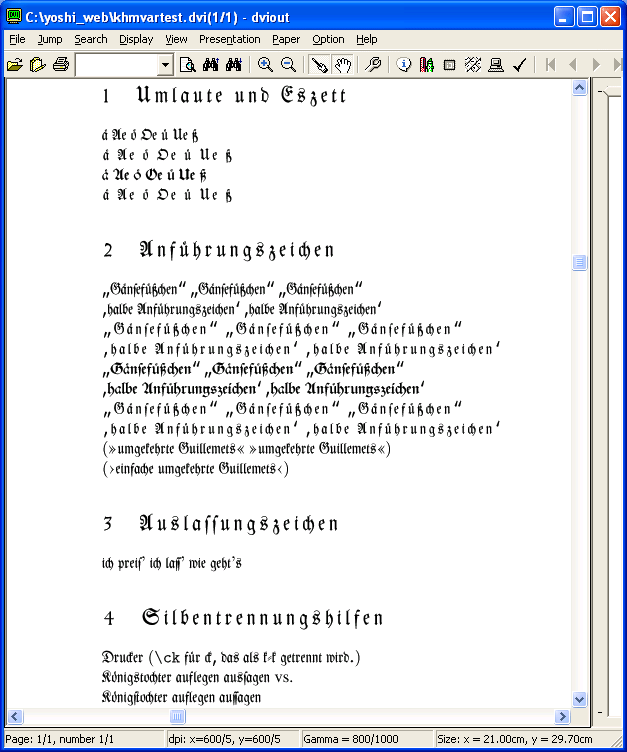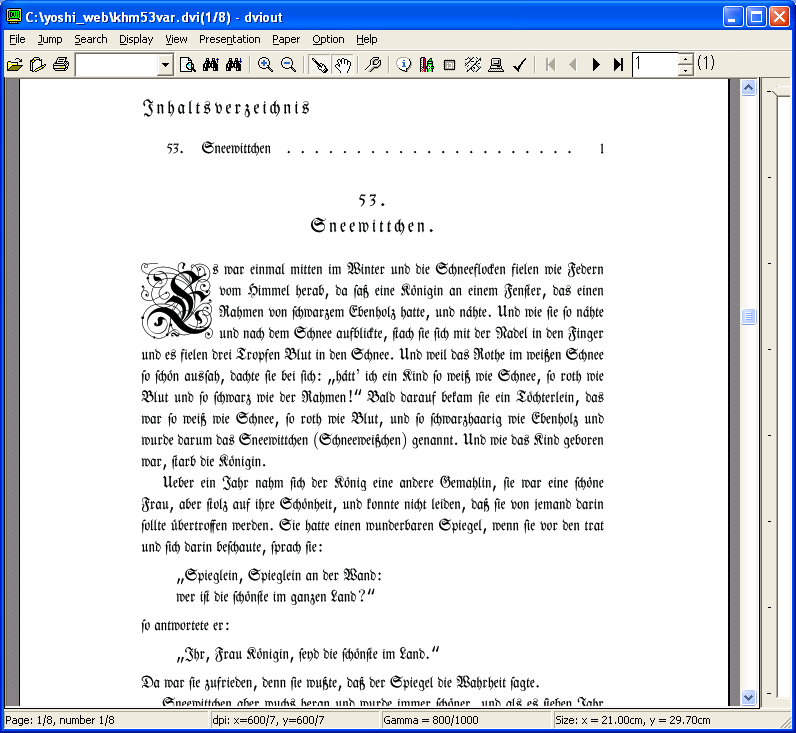khm: a new LaTeX package for typesetting German documents in broken letters (gebrochenen Schriften)
Copyright © Yoshi Nagata
Created: March 22, 2003
Updated: 2022-05-27 11:50:26 [JST: UTC+9]
March 16, 2011
Comment to: 
Files available to download
- Contents
-
The khm-package provides
- TeX virtual fonts for T1 variants of Haralambous' broken typefaces yfrak, yswab and ygoth: ntfrak, ntfrakls, ntswab and ntgoth. These are specially arranged from T. Bronger's tfrak, tfrakls, tswab, tgoth and D. Taupin's cmfrak and dcfrak in order to make them possible to be processed properly in "German" texts. See: "Table 1: Broken Letters in Comparison"
- khm.sty, which includes a set of LaTeX control sequences for typesetting German texts in broken letters. See: "Table 2: Automatic switching from the same input-form to two different Umlaut types"
Table 1: Broken Letters in Comparison: G for good, NG for not good, letter-strings in parentheses are input forms.
|
yfrak + yfonts.sty |
fkt1rm[dcfrak] + mf-frak.sty |
tfrak |
ntfrak + khm.sty |
| Apostroph |
 (geht's:) G (geht's:) G |
 (geht's:) NG (geht's:) NG |
 (geht's) G (geht's) G |
 (geht's) G (geht's) G |
| Gänsefüßchen |
 (``Deutsch'') or ({\glqq}Deutsch{\qrqq}) NG (``Deutsch'') or ({\glqq}Deutsch{\qrqq}) NG |
 (``Deutsch'') or ({\glqq}Deutsch{\qrqq}) G (``Deutsch'') or ({\glqq}Deutsch{\qrqq}) G |
 (,,Deutsch`` or {\glqq}Deutsch{\grqq}) NG (,,Deutsch`` or {\glqq}Deutsch{\grqq}) NG |
 (,,Deutsch``) or ({\glqq}Deutsch{\grqq}) G (,,Deutsch``) or ({\glqq}Deutsch{\grqq}) G |
| halbe Anführungszeichen |
 ({\glq}halb{\grq}) NG ({\glq}halb{\grq}) NG |
 (,halb`) G (,halb`) G |
 ({\glq}halb{\grq}) NG ({\glq}halb{\grq}) NG |
 (,halb`) or ({\glq}halb{\grq} ) G (,halb`) or ({\glq}halb{\grq} ) G |
| a-Umlaut mit e-chen |
 (K*afer) G (K*afer) G |
 (K*afer) G (K*afer) G |
nonexistent NG |
 (K"afer) or (K*afer) G (K"afer) or (K*afer) G |
| A-Umlaut mit Pünktchen |
nonexistent NG |
 ("Arger) G ("Arger) G |
 ("Arger) G ("Arger) G |
 ("Arger) G ("Arger) G |
| was passiert mit bloßer Eingabe »aus«? |
 NG NG |
 NG NG |
 G G |
 G G |
wie soll man eingeben für  ? ? |
(aus:geben) NG[*] | (aus:geben) NG[*] | (aus"|geben) or (aus\/geben) G[*] |
(aus"|geben) or (aus\/geben) G[*] |
| wird ein Leerzeichen automatisch eingefügt vor einem zweiteiligen Satzzeichen [! ? : ;] ? wenn man z. B. eingibt »wie:« |
 NG NG |
 NG NG |
 G G |
 G G |
| was passiert mit der Eingabe »ich preis'«? |
 G G |
 NG NG |
 NG NG |
 G G |
[*]: Input form (aus"|geben) is more ideal because it is the same as of what is defined in german.sty for the ligature unbinding: (Auf"|lage).
 back to contents
back to contents
Note:
- Make sure that your DVI driver can handle virtual fonts.
- cmfrak font (http://www.tex.ac.uk/tex-archive/fonts/gothic/cmfrak/) should already be installed in your LaTeX system.
- Haralambous's fonts (http://www.tex.ac.uk/tex-archive/fonts/gothic/yfrak/, http://www.tex.ac.uk/tex-archive/fonts/gothic/ygoth/, http://www.tex.ac.uk/tex-archive/fonts/gothic/yinit/, http://www.tex.ac.uk/tex-archive/fonts/gothic/yswab/) should also exisist in your system.
- The lettrine.sty LaTeX-stylefile is additionally required when you typeset khm53var.tex(khm53var.tex is one of the sample test files).
Download khm.zip (771KB). Copy the *.mf, *.pfb, *.tfm, *.vf, *.sty, *.tex and *.map files on where your TeX system can find them. Only you have to do is normally to unzip khm.zip file on /usr/local.
The files are to be installed:
- *.mf
- $TEXMFMAIN/fonts/source/public/gothic
- *.pfb
- $TEXMFMAIN/fonts/type1/public/gothic
- *.tfm
- $TEXMFMAIN/fonts/tfm/public/gothic
- *.vf
- $TEXMFMAIN/fonts/vf/public/gothic
- *.sty
- $TEXMFMAIN/tex/latex/khm
- *.tex
- $TEXMFMAIN/tex/latex/khm
- *.map
- $TEXMFMAIN/dvips/config
Edit $TEXMFMAIN/dvips/config/config.ps and $TEXMFMAIN/dvips/config/config.pdf and add the following line at the end of each file.
Edit $TEXMFMAIN/pdftex/base/pdftex.cfg and add the following line at the end of the file.
 back to contents
back to contents
Compile the LaTeX source files *.tex (which you might find at $TEXMFMAIN/tex/latex/khm) as below:
- khm*test.tex
- latex khm*test (khm*test.tex --> khm*test.dvi)
- dvipdfm khmtest (khm*test.dvi --> khm*test.pdf)
- dvips -Ppdf khm*test (khm*test.dvi --> khm*test.ps)
- pdflatex khm*test (khm*test.tex --> khm*test.pdf)
- khm53*.tex
- latex khm53*
latex khm53* (khm53*.tex --> khm53*.dvi)
- dvipdfm khm53* (khm53*.dvi --> khm53*.pdf)
- dvips -Ppdf khm53* (khm53*.dvi --> khm53*.ps)
- pdflatex khm53*
pdflatex khm53* (khm53*.tex --> khm53*.pdf)
The output images of these test files are as below. (khmvartest.tex, khm53var.tex)


 back to contents
back to contents
 back to KHM 2. Ausgabe 1819
back to KHM 2. Ausgabe 1819



